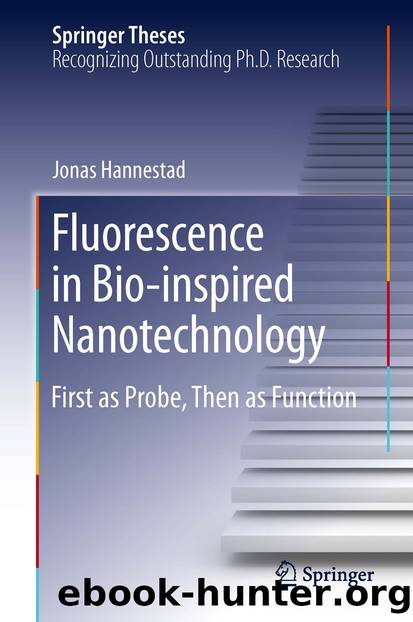Fluorescence in Bio-inspired Nanotechnology by Jonas Hannestad

Author:Jonas Hannestad
Language: eng
Format: epub
Publisher: Springer International Publishing, Heidelberg
Four different assemblages with different chromophoric conformations were constructed. The chromophore assemblies, or triads, have the following dye ratios (donor intermediate donor-acceptor): 6:6:1, 6:3:1, 3:6:1 and 1:1:1 for the triads T1–T4, respectively (Fig. 5.9b). The chromophores (with the exception of the central AF acceptor) are held rigidly close the DNA helix with a relatively well-defined orientation. Because of this, the assumption of random orientation (k2 = 2/3) does not hold. It also means that donor-acceptor distances are relatively well defined (especially for the Py-Cy3 pair). For the T1 assembly (6:6:1), Py-Cy3 distances range between 2.1 and 2.7 nm. The Cy3-AF distance varies slightly more than the Py-Cy3 with a minimum distance at 1.8 nm to a maximum distance at 4.5 nm.
When the assemblies are excited at 380 nm there is a quenching of the donor fluorophore Py for all the triads, T1–T4, compared to an assembly without any of the two acceptors Cy3 and AF. The T1 (6:6:1) and T3 (3:6:1) show a 90 % quenching of Py while T2 (6:3:1) and T4 (1:1:1) show 30 and 70 % quenching, respectively. Comparing the results from the T1 and T2 triads it is clear that a high ratio of intermediate donors is required to achieve an effective donor quenching. However, increasing the amount of intermediate donors beyond a 1:1 ratio does not lead to further quenching of the primary donor (T1 and T3). Finally the difference in donor quenching between T1 and T4 shows that there is an effect of multiple energy transfer paths directing the excitation energy away from the Py donor.
As was the case with the photonic wire, it is not sufficient to just study the quenching of the primary donor to fully characterize the performance of the antenna system. Using the antenna effect measure introduced by Francis and co-workers [39] the efficiency of energy transfer to the terminal acceptor AF is estimated. The reported antenna effects for the T1–T4 triads are 0.85, 0.43, 0.47 and 0.16, respectively. It is interesting to note that the antenna effect of the T2 and T3 triads is approximately half that of T1. T2 has the same number of primary donors as T1 but only half the number of intermediate donors. Th us, T2 absorbs the same amount of light as T1, but the relaying is more inefficient. This is also reflected in the lack of quenching of the primary donor. T3 relays the excitation energy with the same efficiency as T1, but absorbs only half the amount of light that T1 does.
Using the antenna effect measure can be an effective way to characterize the light-harvesting capabilities of an antenna system. However, this measure is highly system specific. Since acceptor emission due to FRET is compared with direct excitation of the donor at the wavelength of maximum absorption, the obtained antenna effect will depend on the quality of the acceptor. The FRET efficiency, which contributes to AE is proportional to the sixth-root of the overlap between the donor emission and acceptor absorption. However, AE is proportional to ε D−1.
Download
This site does not store any files on its server. We only index and link to content provided by other sites. Please contact the content providers to delete copyright contents if any and email us, we'll remove relevant links or contents immediately.
| Automotive | Engineering |
| Transportation |
Whiskies Galore by Ian Buxton(41879)
Introduction to Aircraft Design (Cambridge Aerospace Series) by John P. Fielding(33064)
Small Unmanned Fixed-wing Aircraft Design by Andrew J. Keane Andras Sobester James P. Scanlan & András Sóbester & James P. Scanlan(32743)
Craft Beer for the Homebrewer by Michael Agnew(18140)
Turbulence by E. J. Noyes(7935)
The Complete Stick Figure Physics Tutorials by Allen Sarah(7307)
Kaplan MCAT General Chemistry Review by Kaplan(6866)
The Thirst by Nesbo Jo(6826)
Bad Blood by John Carreyrou(6552)
Modelling of Convective Heat and Mass Transfer in Rotating Flows by Igor V. Shevchuk(6391)
Learning SQL by Alan Beaulieu(6209)
Weapons of Math Destruction by Cathy O'Neil(6142)
Man-made Catastrophes and Risk Information Concealment by Dmitry Chernov & Didier Sornette(5921)
Digital Minimalism by Cal Newport;(5663)
Life 3.0: Being Human in the Age of Artificial Intelligence by Tegmark Max(5474)
iGen by Jean M. Twenge(5366)
Secrets of Antigravity Propulsion: Tesla, UFOs, and Classified Aerospace Technology by Ph.D. Paul A. Laviolette(5309)
Design of Trajectory Optimization Approach for Space Maneuver Vehicle Skip Entry Problems by Runqi Chai & Al Savvaris & Antonios Tsourdos & Senchun Chai(5011)
Pale Blue Dot by Carl Sagan(4912)
